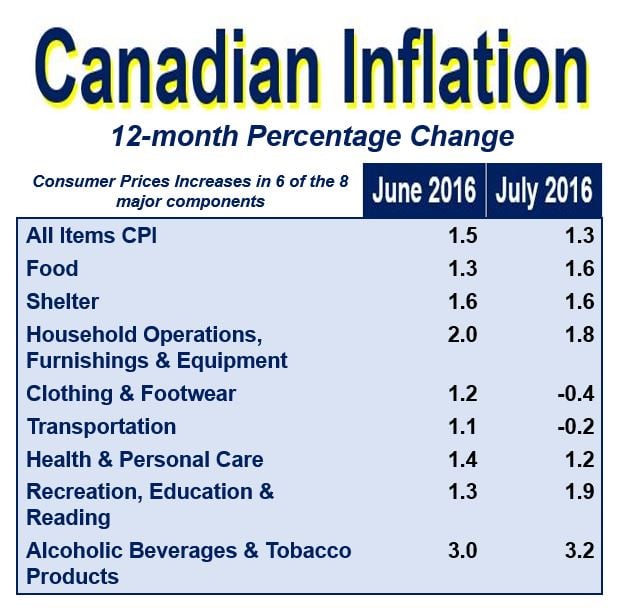There was a surprise fall in inflation in Canada in July to 1.3 percent annualized, as citizens paid less for fuel but more for food and shelter, according to data published by Statistics Canada on Friday.
The Consumer Price Index or CPI (which means inflation) had been at 1.5% in June. Excluding gasoline, prices were 1.9% higher in July 2016 compared to the same month last year – matching June’s non-gasoline gain.
There were price increases in six of the eight major components in the twelve months ending on July 31st 2016, with food and shelter rising the most. The transportation, clothing and footwear indexes were down on a year-over-year basis in July.
 Most analysts and economists had expected inflation in Canada to continue rising strongly in July. They were surprised that price increases slowed down. (Image: statcan.gc.ca)
Most analysts and economists had expected inflation in Canada to continue rising strongly in July. They were surprised that price increases slowed down. (Image: statcan.gc.ca)
The eight major components are:
– Food
– Shelter
– Household operations, furnishings and equipment
– Clothing and footwear
– Transportation
– Health and personal care
– Recreation, education and reading
– Alcoholic beverages and tobacco products
Inflation in Canada – Transportation
After rising 1.1% in June, the Transportation Index fell by 0.2% in the 12 months to July. Gasoline prices in July 2016 compared to July 2015 were 14% down, while in June they were 8.5% down versus June 2015. In July, gasoline was 5.6% lower on a monthly basis.
The purchase of passenger vehicles and subway transportation sub-indexes were 5.4% and 2.1% up respectively on a year-over-year basis in July – they both rose less than in June.
 Inflation in Canada slowed down in July compared to June in all provinces, except for Newfoundland & Labrador, British Columbia, and New Brunswick. (Image: statcan.gc.ca)
Inflation in Canada slowed down in July compared to June in all provinces, except for Newfoundland & Labrador, British Columbia, and New Brunswick. (Image: statcan.gc.ca)
Clothing & Footwear and Food Indexes
The Clothing and Footwear Index rose by 1.2% and 0.4% in June and July respectively. The lower July increase was partly due to a decline in the women’s clothing sub-index, which fell by 0.4% in July compared to a 2.2% increase in June on a year-over-year basis.
Compared with July 2015, shoppers in July 2016 paid less for children’s and men’s clothing.
Food prices increased by 1.3% and 1.6% in June and July respectively compared to the two months one year ago. Food bought in stores were 1.1% more expensive in July year-over-year, following a 0.8% increase in June.
Meat prices were 1.1% up year-over-year in July, compared to a 0.3% increase in June. Meat was a key factor in driving up July food prices. Fresh or frozen fish rose in July by more than in any month since April 2014.
Fresh fruit and vegetables, on the other hand, increased by a smaller amount in July year-over-year than they had done in each of the previous three months.
 When gasoline is taken out of the calculations, the CPI increase in July (1.9%) matched June’s. (Image: statcan.gc.ca)
When gasoline is taken out of the calculations, the CPI increase in July (1.9%) matched June’s. (Image: statcan.gc.ca)
In a commentary, Leslie Preston, a TD Economist, wrote:
“Markets may be worrying about Canada’s economic growth performance, but underlying inflation certainly isn’t raising any eyebrows.”
Recreation, Education and Reading Index
Year-over-year, there was a 1.9% increase in the Recreation, Education and Reading Index in July, compared to a 1.3% gain in June. Video and audio subscriptions were 5% up in July year-over-year.
The Travel Tours Index increased by 0.4% in July compared to July 2015, after falling by 3.4% in June.
Canada’s GDP (gross domestic product) depends on consumer spending for 60% of its growth. Some analysts say that the Canadian consumer is becoming fed up with being seen as the sole driver of economic expansion.
The Globe and Mail quoted David Watt, Chief Economist at HSBC, who said:
“It just suggests that maybe the Canadian consumer is growing a bit tired of carrying the burden of growth. And we don’t really have a lot of other things that are supporting growth right now if the Canadian consumer steps back.”
